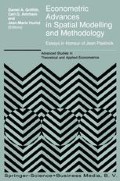Abstract
Location-allocation (LA) models optimally locate service facilities and allocate demand to them. They have been used to locate many types of facility and service (Hodgson et al., 1993). Many different objectives have been optimized in the literature, the most popular being of distance-minimizing or demand-covering types. Whatever the objective, almost without exception, demand is conceived of as occurring in points from which patrons travel to facilities, or from which services are delivered to patrons. There is a growing recognition that not all demands are point-based (expressed by patrons at points), but that demands may be flow-based (expressed by flows, by patrons who are traveling on a pre-determined journey). In this paper, I consider several models which locate facilities to serve flow-based demands.
Access this chapter
Tax calculation will be finalised at checkout
Purchases are for personal use only
Preview
Unable to display preview. Download preview PDF.
References
Berman, O., M. J. Hodgson, and D. Krass. (1995). “Flow intercepting models.” In Facility Location: A Survey of Applications and Methods, edited by Z. Drezner, 427–52. New York: Springer-Verlag.
Berman, O., R.C. Larson, and N. Fouska. (1992). “Optimal location of discretionary service facilities.” Transportation Science, 26, 201–11.
Davies, R. L. and D. S. Rogers, eds. (1984). Store Location and Store Assessment Research. NewYork: John Wiley and Sons.
Church, R. L. and C. S. ReVelle. (1974). “The maximal covering location problem.” Papers of the Regional Science Association, 32, 101–18.
Hodgson, M.J. (1990). “A flow-capturing location-allocation model.” Geographical Analysis, 22, 270–279.
Hodgson, M.J. (1981). “The location of public facilities intermediate to the journey to work.” European Journal of Operational Research, 6, 199–204.
Hodgson, M.J. and O. Berman. (1997). “A billboard location model.” Geographical and Environmental Modelling, 1, 25–45.
Hodgson, M.J. and P. Doyle. (1978). “The location of public services considering the mode of travel.” Socio-Economic Planning Sciences, 12, 25–39.
Hodgson, M.J. and K.E. Rosing. (1992). “A network location-allocation model trading off flow capturing and p-median objectives.” Annals of Operations Research, 40, 247–60.
Hodgson, M.J., K.E. Rosing, and A.L.G. Stonier. (1996a). “Applying the flow capturing location-allocation model to an authentic network: Edmonton, Canada.” European Journal of Operational Research, 90, 427–43.
Hodgson, M. J., K.E. Rosing, and A.L.G. Storrier. (1997). “Testing a bicriterion location-allocation model with real-world network traffic: the case of Edmonton, Canada.” In Multicriteria Analysis, edited by J. Climaco, 484–95. New York: Springer-Verlag.
Hodgson, M.J., K.E. Rosing, and J. Zhang. (1996b). “Locating vehicle inspection stations to protect a transportation network.” Geographical Analysis, 28, 299–314.
Hodgson, M.J., K.E. Rosing, and F. Shmulevitz. (1993). “A review of location-allocation applications literature.” Studies in Locational Analysis, 5, 3–29.
ReVelle, C. S. and R. Swain. (1970). “Central facilities location.” Geographical Analysis, 2, 30–42.
Kuehn, A.A. and O. Hamburger. (1963). “A heuristic program for locating warehouses.” Management Science, 9, 643–66.
Teitz, M.B. and P. Bart. (1968). “Heuristic methods for estimating the generalized vertex median of a weighted graph.” Operations Research, 16, 955–61.
Editor information
Editors and Affiliations
Rights and permissions
Copyright information
© 1998 Springer Science+Business Media Dordrecht
About this chapter
Cite this chapter
Hodgson, M.J. (1998). Developments in Flow-Based Location-Allocation Models. In: Griffith, D.A., Amrhein, C.G., Huriot, JM. (eds) Econometric Advances in Spatial Modelling and Methodology. Advanced Studies in Theoretical and Applied Econometrics, vol 35. Springer, Boston, MA. https://doi.org/10.1007/978-1-4757-2899-6_10
Download citation
DOI: https://doi.org/10.1007/978-1-4757-2899-6_10
Publisher Name: Springer, Boston, MA
Print ISBN: 978-1-4419-4788-8
Online ISBN: 978-1-4757-2899-6
eBook Packages: Springer Book Archive

